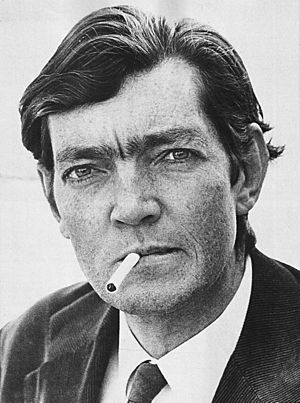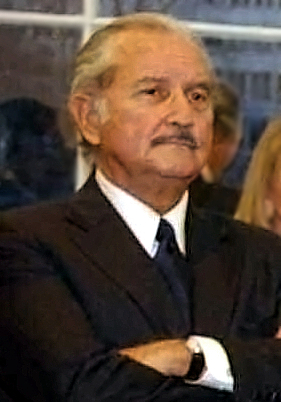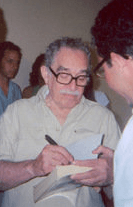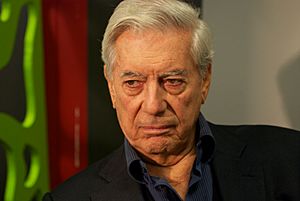Latin American Boom facts for kids
| Literature |
|---|
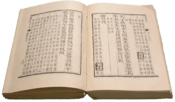 |
| Major forms |
| Genres |
| Media |
|
| Techniques |
| History and lists |
|
| Discussion |
|
The Latin American Boom (Spanish: Boom latinoamericano) was an exciting time in literature during the 1960s and 1970s. It was when a group of talented, relatively young writers from Latin America became super famous. Their books were read all over Europe and the rest of the world!
The most well-known writers of the Boom are Julio Cortázar from Argentina, Carlos Fuentes from Mexico, Mario Vargas Llosa from Peru, and Gabriel García Márquez from Colombia. These authors were inspired by modern writing styles from Europe and North America. They also looked at the Latin American Vanguardia movement, which was all about new and experimental art.
These writers changed how Latin American stories were usually told. Their books were often experimental and also very political. This was because of the political situation in Latin America during the 1960s. Critic Gerald Martin said that in the 1960s, Latin America was known for two main things: the Cuban Revolution and the Latin American Boom in fiction.
The Boom authors became successful quickly. This was partly because their books were some of the first Latin American novels published in Europe. Publishing houses like Seix Barral in Barcelona helped them reach a wider audience. Many of these writers became world-famous. They also spoke out about political and social issues. They reached many readers because their books were translated and they traveled a lot. Sometimes, they even lived in other countries due to political reasons.
Contents
History of the Boom
Why the Boom Happened
The 1960s and 1970s were a time of big political changes in Latin America. The Cold War between the United States and the Soviet Union strongly influenced this period. This political situation was the background for the Boom writers' work. It shaped the world where their new ideas were shared.
A key event was the Cuban Revolution in 1959. After this, the U.S. tried to stop it with the Bay of Pigs Invasion. This made Cuba become closer to the Soviet Union. This led to the Cuban Missile Crisis in 1962, when the U.S. and Soviet Union almost had a nuclear war.
Throughout the 1960s and 1970s, many countries in Latin America, like Argentina, Brazil, and Chile, were ruled by military governments. For example, in 1973, Salvador Allende, the elected president of Chile, was overthrown. General Augusto Pinochet took over and ruled for many years. These governments often worked together to control or remove political opponents.
Between 1950 and 1975, there were big changes in how history and literature were understood. Latin American writers also started to see themselves differently. Cities grew, a large middle class appeared, and communication between Latin American countries increased. The media became more important, and Europe and the United States paid more attention to Latin America. All these things helped the Boom happen.
When the Boom Started
Most experts agree that the Boom began in the 1960s. But they don't all agree on which book was the very first Boom novel. Some say it was Julio Cortázar's Hopscotch from 1963. Others think it was Vargas Llosa's The Time of the Hero from 1962. Some even go back to Augusto Roa Bastos' Hijo de hombre (1959) or Miguel Ángel Asturias's Men of Maize (1949).
The Boom writers felt like they were a "new" literary generation. They admired European writers like James Joyce. But they also wanted to have their own unique Latin American voice. They moved away from older styles of Latin American writing that focused only on rural life.
The End of an Era
The Boom brought a lot of attention to Latin American writers. Their international success changed everything. The success of the Cuban Revolution in 1959 made many people hopeful for a new age.
However, this period of excitement started to fade around 1971. That's when the Cuban government became stricter. A poet named Heberto Padilla was forced to publicly say he was wrong for his "decadent" ideas. This event, known as the Padilla affair, made many Latin American thinkers lose faith in the Cuban government. Some believe this signaled the beginning of the end of the Boom.
But in a way, the Boom never truly ended. The writers from that time kept publishing books. These books reached far more readers than Latin American writers had before the Boom. Authors like Carlos Fuentes and Mario Vargas Llosa are still widely read and translated today.
What Made Boom Novels Special
The novels of the Boom were very modern. They often told stories out of order, jumping around in time. They used different viewpoints or narrators. They also included new words, jokes, and sometimes even rude language.
A key feature of the Boom was its style. It mixed different points of view, questioned linear time, and was technically complex. The writers were confident in their language, using everyday speech without apology.
Other important features of Boom literature include:
- Stories set in both cities and the countryside.
- A global outlook.
- Focus on history and politics.
- Questioning national identity.
- Awareness of global economic and political issues.
- Being very timely and relevant.
Boom literature often blended fantasy with everyday life, creating a new kind of reality. Gabriel García Márquez is especially known for using magical realism. He made this style very popular after publishing One Hundred Years of Solitude in 1967.
Magical Realism
Magical realism is a special way of writing found in many Latin American stories. It happens when history doesn't quite explain everything. So, myths and fantastical elements are used to fill in the gaps.
Early Spanish explorers wrote about the "new world" of the Americas. Their stories of conquering strange lands often included amazing, fantastical details. These stories helped create a new style of writing. This style became magical realism, where unreal things are treated as if they are normal, and normal things are treated as if they are unreal. Plots often combine real experiences with strange, mythical, or impossible elements. It makes it hard to tell what's true, imaginary, or made up.
Historical Fiction
Boom novels also showed a strong interest in history. A great example of this is the "dictator novel." These books showed historical figures and events in a way that clearly connected them to current political situations in Latin America.
For instance, Roa Bastos's I, the Supreme tells the story of a 19th-century dictator in Paraguay. But it was published when another dictator was in power, making the connections clear. Boom novelists understood how their stories could show parallel or alternative histories. They actively joined in discussions about the meaning of history in their region.
Main Boom Writers
Many writers are linked to the Boom, but a few had a huge and undeniable impact. While other names could be added, these writers are always mentioned:
Julio Cortázar
Julio Cortázar was born in Belgium in 1914. His parents were from Argentina. He lived in Switzerland before moving to Buenos Aires at age four. Like other Boom writers, Cortázar questioned his country's politics. He left his teaching job and later moved to France because of his opposition to Juan Perón. He became a French citizen in 1981.
Cortázar supported the Cuban government of Fidel Castro. He also supported Chilean President Salvador Allende and other left-wing movements. In his early stories, politics were usually not a main theme. But his 1973 novel Libro de Manuel was openly political.
Cortázar was influenced by writers like Borges and Edgar Allan Poe. He was perhaps the most experimental of all the Boom authors. His most famous work is the highly experimental novel Hopscotch (1963). This book has 155 chapters. Readers can choose to read them in different orders.
His other works include short story collections like Bestiario (1951) and Todos los fuegos el fuego (1966). He also wrote novels such as Los premios (1960). Cortázar passed away in Paris in 1984.
Carlos Fuentes
Carlos Fuentes was born in 1928. He started publishing in the 1950s. His father was a Mexican diplomat, so Fuentes lived in many cities. These included Buenos Aires, Quito, and Washington, D. C.. His experiences with anti-Mexican discrimination in the U.S. made him look more closely at Mexican culture.
His 1962 novel The Death of Artemio Cruz uses new ways of telling a story. It describes the life of a former Mexican revolutionary as he is dying. Other important books by Fuentes include Where the Air Is Clear (1959) and Terra Nostra (1975).
Fuentes not only wrote important novels but also worked as a critic. In 1955, he helped start the journal Revista Mexicana de Literatura. This journal introduced Latin Americans to European modern writers. Fuentes taught Latin American literature at Columbia University and Harvard. He once said that the Boom was the result of "four centuries" of literature reaching a point where fiction became a way to understand the past. Fuentes died in 2012.
Gabriel García Márquez
Gabriel García Márquez began his career as a journalist. He wrote many well-known non-fiction pieces and short stories. His first published stories appeared in a newspaper in Bogotá in the 1940s.
He is best known for novels like One Hundred Years of Solitude (1967) and The Autumn of the Patriarch (1975). He also wrote No One Writes to the Colonel (1962). Later, he wrote Love in the Time of Cholera (1985). He became very famous and successful for bringing magical realism to the literary world. He explored different ways of looking at reality. He could tell the most unusual things with a very serious expression.
A famous example from One Hundred Years of Solitude is a character floating up to heaven while hanging laundry. García Márquez is now seen as one of the most important authors of the 20th century. He won the 1982 Nobel Prize in Literature. García Márquez passed away in 2014.
Mario Vargas Llosa
Mario Vargas Llosa is a writer from Peru. He writes novels, short stories, plays, and journalism. He also works as a literary and political critic. He studied at the University of San Marcos in Lima and later earned a doctorate in Spain. His thesis was actually about Gabriel García Márquez!
He became famous with his novel The Time of the Hero (1963). This book sharply criticized the cruelty and corruption in a Peruvian military academy. It also hinted at problems in Peruvian society.
Vargas Llosa also wrote The Green House (1966) and the epic Conversation in the Cathedral (1969). Later novels include Aunt Julia and the Scriptwriter (1977). He returned to Lima in 2000 after President Alberto Fujimori resigned. Fujimori had beaten Vargas Llosa in the 1990 Peruvian election. The Swedish Academy gave him the 2010 Nobel Prize in Literature.
Other Important Writers
Several other writers are also connected to the Boom. Juan Rulfo, who wrote only two books (one novel), was a master. He combined social concerns with experimental writing and a unique style. Augusto Roa Bastos from Paraguay wrote Hijo de hombre, which some consider the first Boom novel. His experimental book I, the Supreme is highly praised.
Manuel Puig from Argentina was also a central figure in the publishing world. The Cuban novelist José Lezama Lima is also considered a major figure because of his novel Paradiso (1966). José Donoso is a Chilean writer who belongs to both the Boom and the period after it. He also mentioned other writers linked to the movement, like Jorge Amado from Brazil.
How Books Were Published During the Boom
Publishing played a very important role in the Boom's success. Major publishing houses in cities like Havana, Mexico City, Buenos Aires, and Santiago published most of the Boom novels. These cities became important centers for new cultural ideas.
For example, in Chile, the older generation of writers was quietly replaced by José Donoso. In Colombia, García Márquez became very popular. In Mexico, there was a strong tradition of regional writers.
During this time, Spanish publishing houses in Barcelona became very interested in the Latin American market. This helped Boom novels reach a wider audience. However, these books were sometimes censored by Francisco Franco's government in Spain. A key person in promoting Latin American literature was the agent Carmen Balcells. Vargas Llosa called her "The Big Mama of the Latin American novel."
Impact of the Boom
The Boom had a huge and immediate impact. It changed how Latin American culture was seen around the world. The commercial success of the Boom writers made them almost like rock stars in Latin America. Translations helped them reach a much larger audience. These authors continued to write bestsellers for decades.
The Boom also opened doors for new Latin American writers on the international stage. Many young writers around the world look up to authors like Fuentes, García Márquez, and Vargas Llosa as their mentors.
After the Boom
Since the 1980s, people often talk about "Post-Boom" writers. Most of these writers were born in the 1940s, 1950s, and 1960s. Roberto Bolaño (who wrote By Night in Chile and The Savage Detectives) is a Post-Boom writer who had a big impact.
It's sometimes hard to put writers into clear categories. Some writers, like José Donoso, could be part of both the Boom and the Post-Boom. His novel The Obscene Bird of Night (1970) is a Boom classic. But his later work fits more with the Post-Boom. Also, major Boom writers like Fuentes, García Márquez, and Vargas Llosa kept writing long after the Boom ended.
The Post-Boom is different from the Boom in several ways. One big difference is the presence of female authors. Writers like Isabel Allende (The House of the Spirits), Luisa Valenzuela, Giannina Braschi, Cristina Peri Rossi, and Elena Poniatowska became very important. Some Post-Boom writers use a simpler, easier-to-read style and go back to realism. Others, like Allende, still use magical realism.
See also
 In Spanish: Boom latinoamericano para niños
In Spanish: Boom latinoamericano para niños
- McOndo
|


